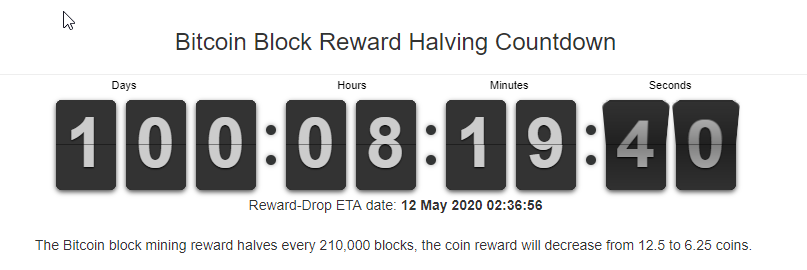Bitcoin halving in 100 days may throw the crypto mining community into a tizzy. Bitcoin has been the most successful cryptocurrency and mining has grown rapidly around it. It is currently miles ahead of the competition, hovering around $9000 a bitcoin. Mining has been profitable till now but the halving will reduce the percentages even lower.
Bitcoin’s long-awaited halving is set to take place in 100 days. From then on, the asset will become twice as scarce.
The most anticipated cryptocurrency event is almost upon us: Bitcoin’s halving. Estimated to take place on May 12, 2020, we are just 100 days away from mining rewards being cut by half. That means Bitcoin is about to get a lot scarcer—and likely more valuable, as a result.
Here at BeInCrypto, the topic has been covered quite extensively from all angles. For example, Bitcoin is in a unique position now because it has more fiat on-ramps than ever before. Analysts are split on whether we can expect a significant price bump before or after the halving event, however. One study by Messari controversially found that it may already be priced-in and took issue with the commonly-cited stock-to-flow ratio in predicting future price movements.
A debate has been raging on whether this may be the case, with many settling on the idea that positive movement will only happen after the halving. Some have even made the bold claim that Bitcoin could reach as high as $400,000 after the halving based on historical trends. However, the past performance does not equal future performance so we should be wary of making simplistic comparisons.
What is halving?
Bitcoin mining happens through “blocks”. When a block is discovered, the discoverer may award themselves a certain number of bitcoins, which is agreed-upon by everyone in the network. Currently this bounty is 12.5 bitcoins; this value will halve every 210,000 blocks. See Controlled Currency Supply.
Additionally, the miner is awarded the fees paid by users sending transactions. The fee is an incentive for the miner to include the transaction in their block. In the future, as the number of new bitcoins miners are allowed to create in each block dwindles, the fees will make up a much more important percentage of mining income.
The largest cryptocurrency will go through serious network changes, which will surely have an impact on miners. Those are the backbone of the Bitcoin blockchain. Bitcoin halving in 100 days puts pressure on that.
The work miners do is essential for the network’s state of security. In theory, the more computational power they put in, the harder it would be to take over the consensus and impact it negatively. The hash rate recently recorded a new all-time high of over 120,000,000 TH/s. This suggests that the network’s security is getting more and more robust.



